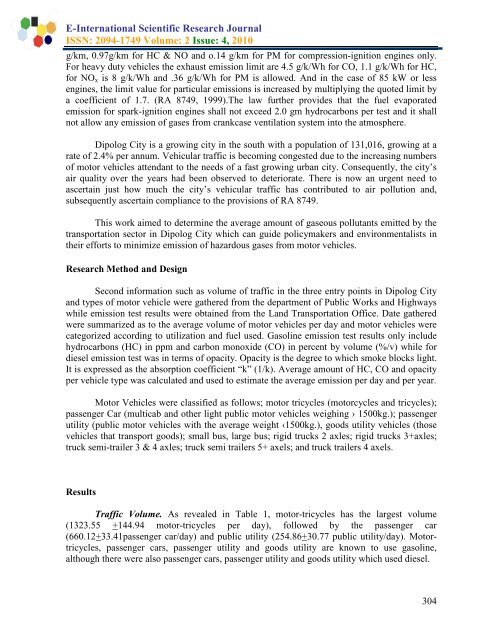download the full article here - EISRJC
download the full article here - EISRJC
download the full article here - EISRJC
You also want an ePaper? Increase the reach of your titles
YUMPU automatically turns print PDFs into web optimized ePapers that Google loves.
E-International Scientific Research JournalISSN: 2094-1749 Volume: 2 Issue: 4, 2010g/km, 0.97g/km for HC & NO and o.14 g/km for PM for compression-ignition engines only.For heavy duty vehicles <strong>the</strong> exhaust emission limit are 4.5 g/k/Wh for CO, 1.1 g/k/Wh for HC,for NO x is 8 g/k/Wh and .36 g/k/Wh for PM is allowed. And in <strong>the</strong> case of 85 kW or lessengines, <strong>the</strong> limit value for particular emissions is increased by multiplying <strong>the</strong> quoted limit bya coefficient of 1.7. (RA 8749, 1999).The law fur<strong>the</strong>r provides that <strong>the</strong> fuel evaporatedemission for spark-ignition engines shall not exceed 2.0 gm hydrocarbons per test and it shallnot allow any emission of gases from crankcase ventilation system into <strong>the</strong> atmosp<strong>here</strong>.Dipolog City is a growing city in <strong>the</strong> south with a population of 131,016, growing at arate of 2.4% per annum. Vehicular traffic is becoming congested due to <strong>the</strong> increasing numbersof motor vehicles attendant to <strong>the</strong> needs of a fast growing urban city. Consequently, <strong>the</strong> city’sair quality over <strong>the</strong> years had been observed to deteriorate. T<strong>here</strong> is now an urgent need toascertain just how much <strong>the</strong> city’s vehicular traffic has contributed to air pollution and,subsequently ascertain compliance to <strong>the</strong> provisions of RA 8749.This work aimed to determine <strong>the</strong> average amount of gaseous pollutants emitted by <strong>the</strong>transportation sector in Dipolog City which can guide policymakers and environmentalists in<strong>the</strong>ir efforts to minimize emission of hazardous gases from motor vehicles.Research Method and DesignSecond information such as volume of traffic in <strong>the</strong> three entry points in Dipolog Cityand types of motor vehicle were ga<strong>the</strong>red from <strong>the</strong> department of Public Works and Highwayswhile emission test results were obtained from <strong>the</strong> Land Transportation Office. Date ga<strong>the</strong>redwere summarized as to <strong>the</strong> average volume of motor vehicles per day and motor vehicles werecategorized according to utilization and fuel used. Gasoline emission test results only includehydrocarbons (HC) in ppm and carbon monoxide (CO) in percent by volume (%/v) while fordiesel emission test was in terms of opacity. Opacity is <strong>the</strong> degree to which smoke blocks light.It is expressed as <strong>the</strong> absorption coefficient “k” (1/k). Average amount of HC, CO and opacityper vehicle type was calculated and used to estimate <strong>the</strong> average emission per day and per year.Motor Vehicles were classified as follows; motor tricycles (motorcycles and tricycles);passenger Car (multicab and o<strong>the</strong>r light public motor vehicles weighing › 1500kg.); passengerutility (public motor vehicles with <strong>the</strong> average weight ‹1500kg.), goods utility vehicles (thosevehicles that transport goods); small bus, large bus; rigid trucks 2 axles; rigid trucks 3+axles;truck semi-trailer 3 & 4 axles; truck semi trailers 5+ axels; and truck trailers 4 axels.ResultsTraffic Volume. As revealed in Table 1, motor-tricycles has <strong>the</strong> largest volume(1323.55 +144.94 motor-tricycles per day), followed by <strong>the</strong> passenger car(660.12+33.41passenger car/day) and public utility (254.86+30.77 public utility/day). Motortricycles,passenger cars, passenger utility and goods utility are known to use gasoline,although <strong>the</strong>re were also passenger cars, passenger utility and goods utility which used diesel.304
















